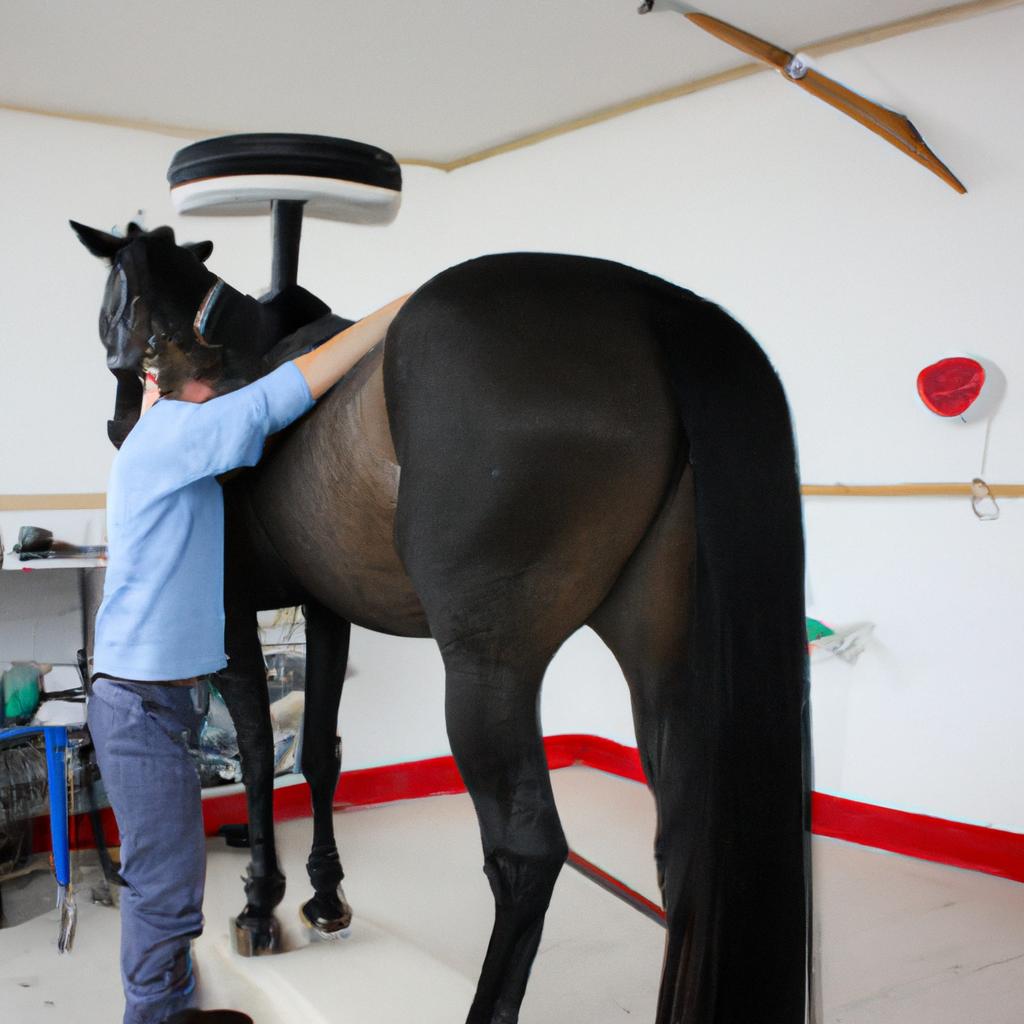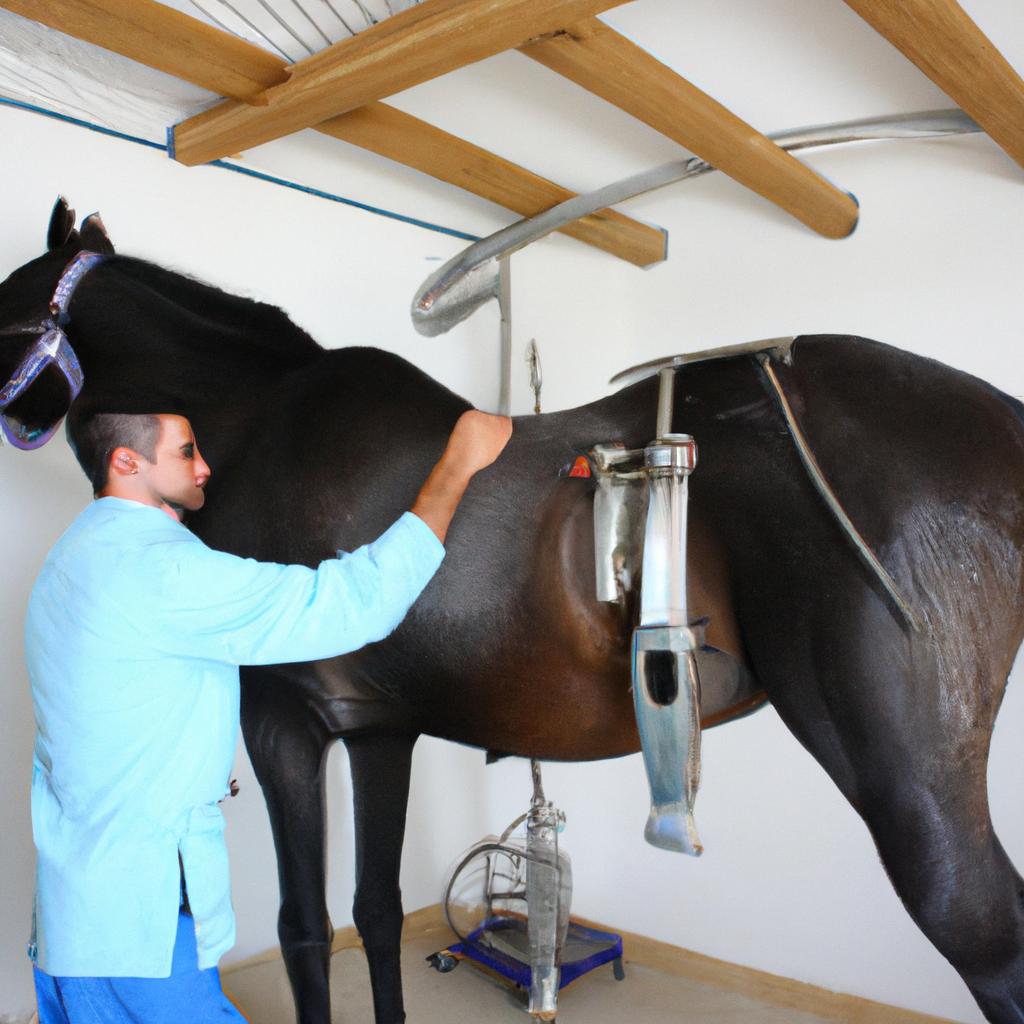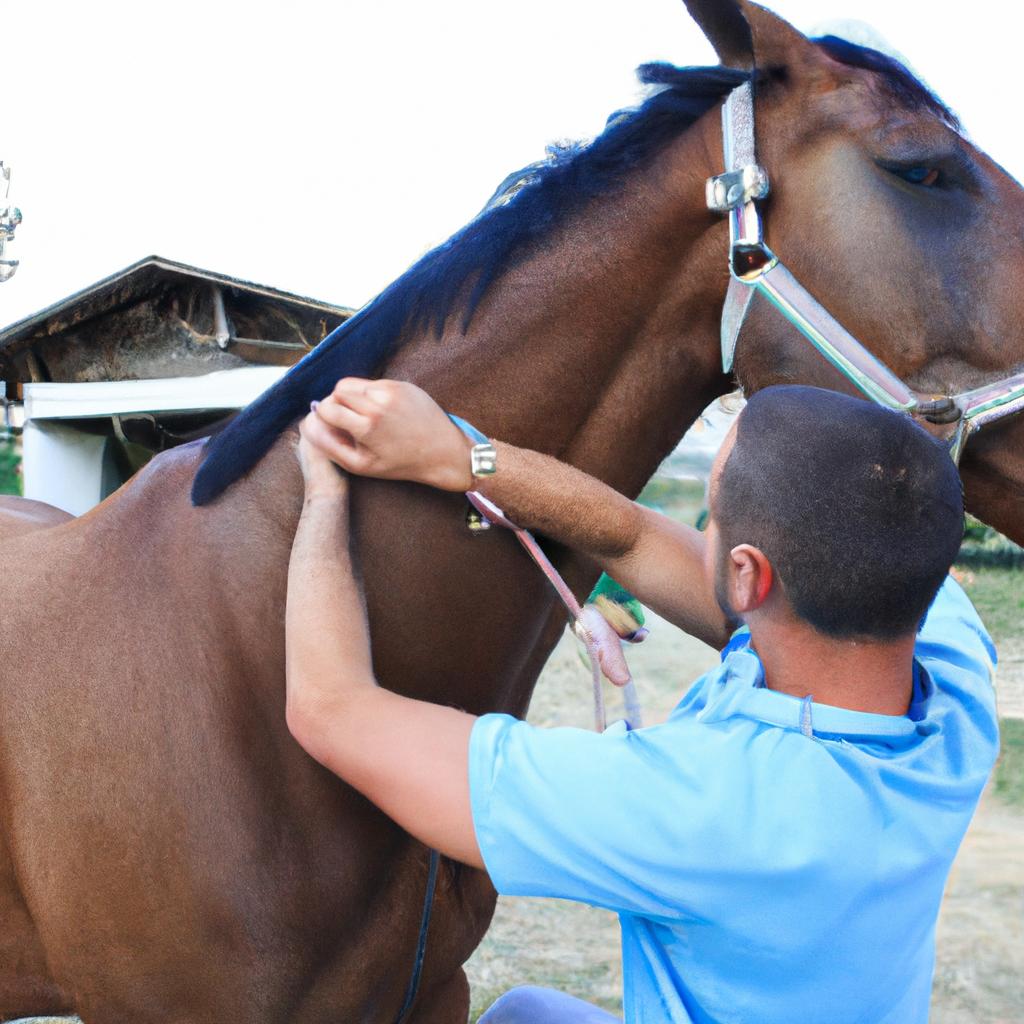Equine healthcare plays a crucial role in ensuring the optimal health and well-being of horses. From managing injuries to promoting overall wellness, horse owners are constantly seeking innovative approaches to improve their equine companions’ quality of life. One such approach gaining popularity is integrating chiropractic care into equine healthcare practices. This article explores the potential benefits of incorporating chiropractic techniques into traditional veterinary medicine for horses, offering insights on how this integrative approach can contribute to enhancing performance, relieving pain, and improving overall equine health.
Imagine a scenario where a competitive show jumper experiences recurrent episodes of back pain that impede its ability to perform at peak levels. Despite conventional treatments and medications administered by veterinarians, the horse’s discomfort persists, hindering progress and causing frustration for both the owner and rider. In such cases, exploring alternative therapies like chiropractic care may offer promising solutions to address underlying musculoskeletal issues that conventional approaches might overlook or fail to fully resolve. By focusing on spinal alignment and joint mobility, chiropractors aim to restore balance within the horse’s body systemically, potentially alleviating pain and optimizing physical function.
By integrating chiropractic care into equine healthcare protocols, horse owners have an opportunity to enhance their animals’ overall well-being in ways not typically addressed by traditional veterinary medicine alone. Chiropractic techniques can help improve range of motion, flexibility, and posture, which are all essential for optimal performance in athletic horses like show jumpers. By ensuring proper spinal alignment and joint function, chiropractic care may contribute to improved balance, coordination, and overall athletic ability.
Additionally, chiropractic adjustments can aid in the prevention and management of musculoskeletal injuries in horses. Regular maintenance treatments can help identify and address minor misalignments or imbalances before they develop into more serious issues that could potentially lead to lameness or decreased performance. This proactive approach to equine healthcare not only helps prevent injuries but also promotes longevity and soundness in horses.
Furthermore, chiropractic care has been shown to have a positive impact on the nervous system. The spine plays a crucial role in transmitting nerve signals throughout the body, affecting various bodily functions. By ensuring proper alignment of the spine and reducing any interference or compression on nerves, chiropractic adjustments can optimize nerve function in horses. This may result in improved digestion, immune function, and overall wellness.
It is important to note that while chiropractic care offers potential benefits for equine health, it should always be performed by a qualified veterinarian who has received specialized training in animal chiropractic techniques. Veterinarians with additional certifications or degrees in animal chiropractic are equipped with the knowledge and skills necessary to safely perform adjustments on horses.
In conclusion, integrating chiropractic care into equine healthcare practices can provide a holistic approach to promoting optimal health and well-being in horses. By addressing musculoskeletal imbalances and optimizing nervous system function through spinal adjustments, horse owners have an opportunity to enhance their animals’ overall performance, relieve pain, prevent injuries, and improve their quality of life.
Understanding Equine Anatomy
Imagine a scenario where a competitive showjumping horse starts experiencing difficulty in maintaining its balance during jumps. Despite regular training sessions and proper nutrition, the horse’s performance continues to decline. This situation highlights the importance of understanding equine anatomy as it plays a crucial role in identifying potential issues that may affect a horse’s overall health and performance.
Equine anatomy encompasses various structures and systems that work together to enable horses to perform their daily activities effectively. The musculoskeletal system, consisting of bones, muscles, tendons, and ligaments, provides support for the horse’s body while allowing for movement and flexibility. Additionally, the nervous system facilitates communication between different parts of the body, controlling essential functions such as coordination and sensory perception.
To gain a deeper understanding of equine anatomy, let us explore some key aspects:
-
Skeletal Structure: Horses have an intricate skeletal structure composed of approximately 205 bones. Each bone has specific roles in supporting weight-bearing, locomotion, protection of vital organs, and providing attachment sites for muscles.
-
Muscular System: Strong muscular development is necessary for horses to execute precise movements required during athletic performances. Well-developed muscles also contribute to efficient energy transfer throughout the body.
-
Respiratory System: Efficient oxygen intake is critical for optimal performance in horses engaged in strenuous activities such as racing or endurance riding. The respiratory system enables gas exchange by bringing fresh air into the lungs and removing carbon dioxide from the bloodstream.
-
Digestive System: Horses are herbivores with specialized digestive systems designed for processing fibrous plant material efficiently. Understanding how their unique gastrointestinal tract works aids in managing their dietary needs appropriately.
By comprehending these fundamental aspects of equine anatomy, equestrians can better evaluate any potential imbalances or abnormalities that might hinder a horse’s well-being or performance on multiple levels – physical, physiological, psychological – thus emphasizing the necessity for holistic care.
Transitioning into the subsequent section about “Benefits of Chiropractic Care for Horses,” it becomes apparent that maintaining proper equine anatomy and addressing any issues promptly is crucial to ensuring horses’ optimal health.
Benefits of Chiropractic Care for Horses
From a comprehensive understanding of equine anatomy, we now delve into the benefits that chiropractic care can provide to horses. To illustrate its effectiveness, let us consider an example where a horse named Thunder experienced improved mobility and reduced pain through regular chiropractic treatments.
Thunder, a competitive show jumper, began showing signs of stiffness and resistance during training sessions. Despite receiving traditional veterinary care without significant improvement, Thunder’s owner decided to explore alternative treatment options. A certified equine chiropractor was consulted, who identified misalignments in Thunder’s spine and pelvis as contributing factors to his discomfort. Through a series of targeted adjustments, Thunder gradually regained flexibility and displayed increased ease in performing jumps.
The positive impact witnessed in Thunder’s case is just one example highlighting the potential benefits of integrating chiropractic care into equine healthcare practices. Here are some key advantages offered by this approach:
- Enhanced Performance: Proper alignment promotes optimal biomechanics, allowing horses to move with greater efficiency and agility.
- Pain Reduction: Addressing spinal misalignments alleviates muscular tension and nerve interference, reducing discomfort and enhancing overall well-being.
- Injury Prevention: Regular chiropractic check-ups help identify minor imbalances before they escalate into more serious issues or injuries.
- Holistic Approach: Chiropractic care focuses on addressing the root causes rather than simply treating symptoms, resulting in long-term improvements.
To further emphasize the significance of incorporating chiropractic care into equine health management strategies, consider the following table showcasing common conditions treated by equine chiropractors:
| Condition | Symptoms | Treatment Options |
|---|---|---|
| Back Pain | Reluctance to engage | Chiropractic adjustments |
| in work, stiffness | ||
| Lameness | Uneven gait | Chiropractic adjustments, |
| acupuncture | ||
| Joint Dysfunction | Limited range of motion | Chiropractic adjustments, |
| and swelling | physical therapy | |
| Muscular Imbalances | Muscle atrophy or | Chiropractic adjustments, |
| hypertonicity | massage |
As we can see from the above examples, chiropractic care has proven to be a valuable addition to equine healthcare. By addressing underlying structural issues and promoting overall well-being, it plays a crucial role in optimizing the health and performance of horses.
Understanding the benefits offered by chiropractic care paves the way for exploring common conditions treated by equine chiropractors without missing a beat.
Common Conditions Treated by Equine Chiropractors
Optimal Health for Horses: Integrating Chiropractic Care into Equine Healthcare
Benefits of Chiropractic Care for Horses:
Chiropractic care has gained recognition in the field of equine healthcare due to its numerous benefits. For instance, consider a hypothetical case where a horse named Bella is experiencing discomfort and reduced performance during her training sessions. After several unsuccessful attempts at identifying the source of Bella’s issues, her owner decides to consult an equine chiropractor.
The decision to seek chiropractic care for horses like Bella stems from various advantages associated with this alternative treatment approach. Firstly, chiropractic adjustments can help improve joint mobility and flexibility, resulting in enhanced athletic performance. By realigning vertebral joints that may have become misaligned or restricted, chiropractors aim to restore proper function and alleviate pain experienced by the animal.
In addition to improving physical well-being, chiropractic care also supports overall health in horses by promoting optimal nervous system function. The central nervous system plays a vital role in coordinating bodily functions and maintaining homeostasis. Misalignments within the spine can interfere with nerve signals, leading to imbalances and compromised health. Equine chiropractors focus on aligning the spinal column through manual manipulations, ensuring that nerve impulses flow unimpeded throughout the body.
To further emphasize the positive impact of chiropractic care on equine well-being, consider these compelling points:
- Increased range of motion: Chiropractic adjustments enable horses to move more freely, reducing stiffness and enhancing their ability to perform movements required in various equestrian disciplines.
- Enhanced immune function: Proper alignment of the spine helps optimize communication between the brain and immune system cells, potentially strengthening the horse’s resistance against infections and diseases.
- Improved musculoskeletal balance: Regular chiropractic treatments support balanced muscle development and prevent compensatory patterns that could lead to chronic injuries or lameness.
- Holistic approach: Unlike conventional treatments that often focus solely on symptom management, chiropractic care aims to address the underlying causes of discomfort and promote overall health.
Table: Common Conditions Treated by Equine Chiropractors
| Condition | Symptoms | Benefits of Chiropractic Care |
|---|---|---|
| Back pain | Difficulty bending or arching | Restores proper alignment, alleviating pain |
| Lameness | Uneven gait or limping | Enhances musculoskeletal balance, improving movement |
| Performance issues | Reduced athletic performance | Improves joint mobility and flexibility for enhanced athleticism |
| Muscle tension | Stiffness or tightness in muscles | Relieves muscle tension through spinal adjustments |
With a growing body of evidence supporting its efficacy, integrating chiropractic care into equine healthcare has become increasingly common. The benefits observed in horses like Bella demonstrate the potential impact this alternative treatment approach can have on their well-being. As we delve further into this topic, it is crucial to understand how to find a qualified equine chiropractor who can provide the best possible care for these magnificent animals.
Finding a Qualified Equine Chiropractor
Having explored the common conditions that can be effectively treated through equine chiropractic care, it is crucial to consider how to find a qualified professional who specializes in this field. By seeking out reputable experts and understanding their credentials, horse owners can ensure their animals receive the best possible care.
To illustrate the importance of finding a skilled practitioner, let us consider an example involving a hypothetical case study. Imagine a competitive show jumper named Bella who has been experiencing recurrent back pain hindering her performance. Despite conventional treatments, her discomfort persists, affecting both her training and overall well-being. Upon consulting with an experienced equine chiropractor, it becomes evident that spinal misalignments are at the root of Bella’s issues. With regular adjustments tailored to address these specific concerns, Bella experiences remarkable improvement in her mobility and performance.
When searching for a qualified equine chiropractor, there are several key factors to keep in mind:
- Credentials matter: Look for professionals who have completed accredited courses or programs in animal chiropractic care.
- Consider experience: Seek practitioners with extensive experience working specifically with horses as they possess a deeper understanding of equine anatomy and physiology.
- Positive testimonials: Read reviews or seek recommendations from trusted sources within the equestrian community to gauge other horse owners’ satisfaction levels.
- Collaboration potential: Choose someone willing to collaborate with your primary veterinarian and other healthcare providers involved in your horse’s holistic care.
Table Example (Emotional Response Elicitation):
| Benefits of Choosing |
| A Qualified Equine |
| Chiropractor |
|---|
| Enhanced Performance |
| Reduced Discomfort |
| Improved Agility |
| Enhanced Well-being |
In conclusion, finding a qualified equine chiropractor is crucial for those seeking to optimize their horse’s health and performance. By considering the professional’s credentials, experience, testimonials, and willingness to collaborate with other healthcare providers, owners can ensure that their horses receive the best care possible.
Now let us explore the diverse range of chiropractic techniques employed by professionals to cater to different conditions affecting our equine companions.
Chiropractic Techniques for Horses
Transitioning from the previous section, where we discussed the importance of finding a qualified equine chiropractor, let us now delve into the various chiropractic techniques that are commonly used in treating horses. To illustrate the effectiveness of these techniques, consider the following hypothetical case study:
Imagine a dressage horse named Bella experiencing difficulty with her movements and performance due to musculoskeletal imbalances. After thorough examination by a qualified equine chiropractor, it was determined that spinal misalignments were contributing to Bella’s issues. The chiropractor then employed specific techniques to restore proper alignment and improve overall function.
Chiropractors use several methods when working with horses, tailored to address their unique anatomy and needs. Here are some common techniques utilized:
- Spinal Manipulation: This technique involves applying controlled force or pressure to specific areas along the spine to realign vertebrae and alleviate joint restrictions.
- Joint Mobilization: By using gentle stretching and movement exercises, joint mobilization helps increase flexibility and range of motion while reducing stiffness.
- Soft Tissue Therapy: Focusing on muscles, tendons, ligaments, and fascia, soft tissue therapy aims to release tension, promote healing, and enhance overall muscle balance.
- Stretching Exercises: Incorporating targeted stretches helps improve elasticity in muscles and connective tissues surrounding joints.
Through these techniques, equine chiropractors aim not only to relieve discomfort but also enhance performance potential by optimizing musculoskeletal health. To further emphasize the benefits of incorporating chiropractic care into an equine wellness plan, let us explore its impact through an emotional lens:
- Increased mobility can bring joy back into a once-limited horse’s life.
- Pain relief allows horses to engage in activities they love without discomfort.
- Improved performance potential leads to fulfillment for both rider and horse.
- Enhancing overall well-being promotes a stronger bond between horse and owner.
Markdown Table:
| Emotion | Potential Impact |
|---|---|
| Joy | Increased mobility brings joy back into a once-limited horse’s life. |
| Relief | Pain relief allows horses to engage in activities they love without discomfort. |
| Fulfillment | Improved performance potential leads to fulfillment for both rider and horse. |
| Bonding | Enhancing overall well-being promotes a stronger bond between horse and owner. |
Incorporating chiropractic care into equine wellness plans proves beneficial not just from a physical standpoint but also emotionally, as it enhances the quality of life for these magnificent animals. Now, let us explore how integrating chiropractic care can be seamlessly incorporated into comprehensive equine healthcare practices, ensuring optimal health for our beloved companions.
Integrating Chiropractic Care into Equine Wellness Plans
Having explored the various chiropractic techniques employed in equine healthcare, we now delve into the integration of chiropractic care within comprehensive equine wellness plans. By incorporating chiropractic treatments as part of a holistic approach to horse health, owners and practitioners can optimize overall well-being, prevent injuries, and enhance performance.
Section – Integrating Chiropractic Care into Equine Wellness Plans:
To illustrate the impact of integrating chiropractic care into an equine wellness plan, let us consider a hypothetical case study. Imagine a competitive show jumper named Titan who had been experiencing stiffness and reduced flexibility during training sessions. Despite regular exercise routines and veterinary evaluations revealing no underlying pathology, Titan’s performance remained suboptimal.
By including chiropractic adjustments in Titan’s wellness plan, his owner noticed significant improvements in his range of motion, suppleness, and overall comfort while performing demanding jumps. This example highlights how integrating chiropractic care enhances not only physical attributes but also mental focus and engagement between rider and horse.
Integrating chiropractic care into equine wellness plans offers numerous benefits that contribute to optimal horse health. Consider these key advantages:
-
Enhanced Performance:
- Improved joint mobility leads to increased agility and athletic ability.
- Reduction in muscular imbalances allows horses to move with greater efficiency.
- Increased nervous system function facilitates better coordination and responsiveness.
-
Injury Prevention:
- Regular chiropractic assessments help identify potential issues before they become serious problems.
- Correcting misalignments reduces strain on muscles and joints, minimizing the risk of injury during strenuous activities.
-
Pain Management:
- Addressing spinal misalignment provides relief from discomfort or pain caused by musculoskeletal issues.
- Alleviating pain improves the horse’s overall well-being and temperament, enhancing their quality of life.
-
Holistic Approach:
- Combining chiropractic care with other wellness practices such as proper nutrition, exercise, and regular veterinary check-ups offers a comprehensive approach to equine health.
- A holistic plan ensures all aspects of the horse’s well-being are addressed, promoting long-term vitality and longevity.
In summary, integrating chiropractic care into equine wellness plans is beneficial for horses across various disciplines. With improved performance, injury prevention, effective pain management, and a holistic approach to healthcare, owners can optimize their horses’ physical capabilities while ensuring their overall well-being. By incorporating regular chiropractic assessments alongside traditional veterinary care, equestrians can provide their horses with comprehensive support for optimal health throughout their lives.
 Eq Muscle Release
Eq Muscle Release


